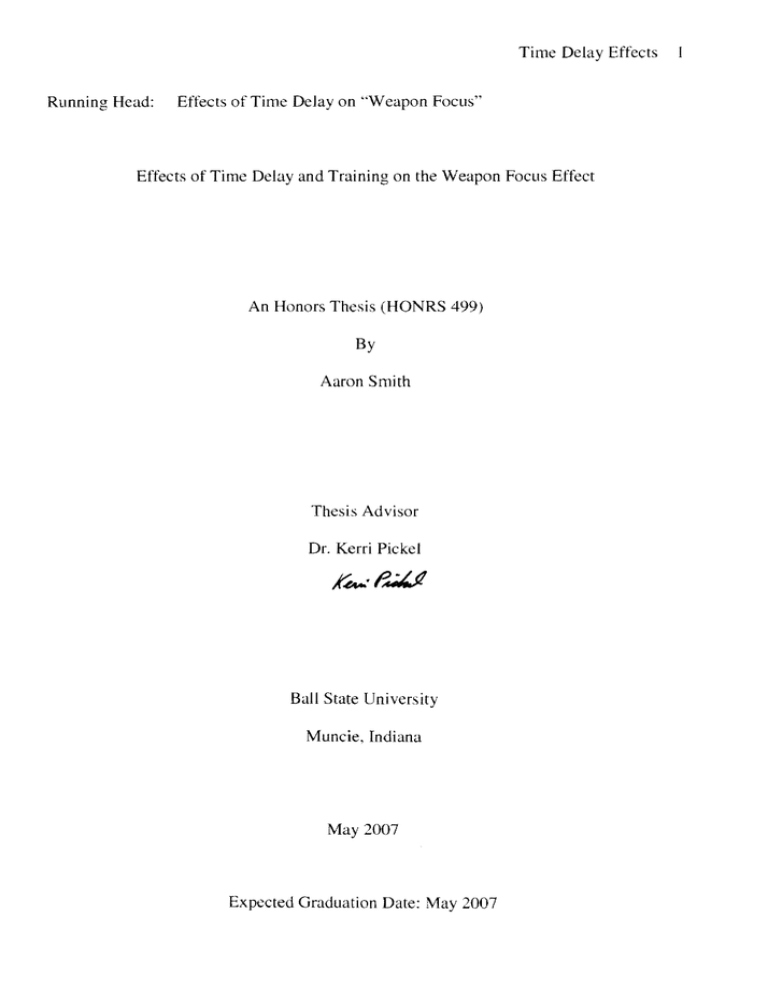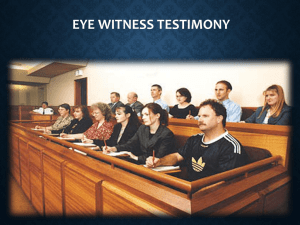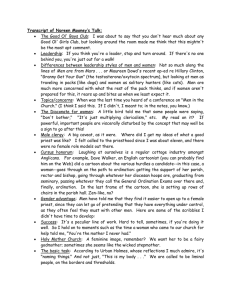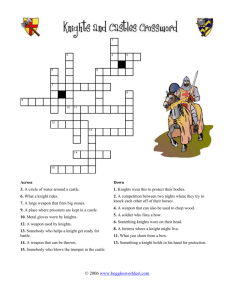Time Delay Effects Running Head: Effects of Time Delay on "Weapon Focus"
advertisement

Time Delay Effects Running Head: Effects of Time Delay on "Weapon Focus" Effects of Time Delay and Training on the Weapon Foclls Effect An Honors Thesis (HONRS 499) By Aaron Smith Thesis Advisor Dr. Kerri Pickel ,f'.e..-.~ BaH State University Muncie, Indiana May 2007 Expected Graduation Date: Mav 2007 ~,'(cfi fi l~ . ~';;' ,\ I Acknowledgements ,$0i.f First and foremost, I would like to thank Dr. Kerri Pickel for her constant aid and devotion in making this a successful research project. If not for her suggestions and assistance this would not have been possible, I would also like to thank Mr. John Wallace for offering time out of his class schedule to assist me in the completion of this project. Last but certainly not least, I would like to offer my most heartfelt thanks to Mr. Ronald Truelove for introducing me to Cognitive and Forensic Psychology and for starting me down the path of a researcher. Thank you all. Time Delay Effects 2 Abstract "Weapon focus" has become a topic of great interest among cognitive psychologists. A study has shown that some of the effects of witnessing a weapon can be negated by informing the observer of these effects and encouraging them to avoid fixating on the weapon. The present study measured the effectiveness and duration of the informational treatment by utilizing a time delay between presentation of the information and the actual event I have made no specific prediction regarding the effects of delay but it is possible that training may still have an effect. To test this, a group of Midwestern university students were given a lecture on either weapon focus or a control topic. Approximately one week later the students observed a video of a robber and their subsequent recognition and memory for the robber's clothes and features will be tested for accuracy. Weapon fixation was inferred if recognition suffered when a weapon was present. There was no main effect of either independent variable. There was no main effect of the object, F( I, 58) F( 1, 58) = .54, p =.47. = .24, P = .63 and no main effect of lecture, There was an interaction obtained due to these differences, F(1, 58) = 9.39,p = .003. Time Delay Effects 3 Effects of Time Delay and Training upon "Weapon Focus" and Eyewitness Recall New research in the area of human memory has yielded some important discoveries about the nature of encoding and recall. The phenomenon known as "weapon focus" has become of great interest in recent years as many different researchers in many different settings have demonstrated its effects (Kramer, Buckhout, & Eugenio, 1990; Loftus, Loftus, & Messo, 1987; Maass & Kohnken, 1989; Mitchell, Livosky, & Mather, 1998; Steblay, 1992; Pickel, 1998, 1999; Pickel, Ross, & Truelove, 2006). The effects refer to the distracting nature of the presence of a weapon upon the recall of an eyewitness (Loftus et aI., 1987). Specifically, it appears as though this object weapon or not, interferes with the encoding of perceived information leading to a deficit in the later recall of information regarding the individual holding the weapon. Loftus et al. ( 1987) subjected participants to a slide show showing both neutral and weapon slides. During the video participants observed a target character, holding either a gun or a personal check, in a restaurant interacting with the cashier. Eye fixations were then measured, and it was found that individuals viewing the gun fixated on that object significantly longer than on the neutral object. This indicates that, when a weapon is present, observers do in fact look upon weapon longer than a neutral object. The experiments also found the recall of individuals observing a weapon was less accurate than that of control individuals. Time Delay Effects 4 Maass and Kohnken ( 1989) had similar results but found the weapon did not necessarily have to be observed in a scene or with an overt threat of immediate harm to the eyewitness. This study replicated previous findings about the weapon focus effect by using a syringe or a pen held by an interviewer. Conditions were further manipulated to measure the effects of threat. Some participants were told they would receive an injection while the others were not given this added threat. Participants were then asked to identify the interviewer in a lineup and to provide a description of the interviewer. Participants in the weapon condition performed more poorly on recall tasks as well as the lineup recognition task than the controls. Maass and Kohnken also discovered no significant difference between those weapon groups that were threatened as opposed to those where the weapon was merely present. Pickel ( 1999) provides support for a contextual explanation of the weapon focus effect. Two experiments were conducted. The first included conditions in which a gun would be either consistent with the scene (the action took place at a shooting range) or inconsistent (the setting is a city park). In this experiment, respondents observed, and later described, a control person and a man carrying the weapon. Pickel found no difference with memory for the control, but witnesses' memory for the man was impaired by the weapon in the inconsistent but not the consistent seuing. Also the degree of threat from the man seemed to have no effect upon recall. This supports the findings of Pickel (1999) that weapons are distracting because of their unusual nature instead of their threatening nature. Time Delay Effects 5 In the second experiment individuals observed either a priest or a police officer holding either a cell phone or a gun. The study demonstrated that participants observing the gun did worse than participants seeing the phone, but only if the target person had an occupation (priest) that was inconsistent with the gun. The findings in the second experiment support the findings of the first experiment. This adds further support to the explanation of the weapon focus effect as a function of unusualness. Further evidence is now available demonstrating an effect of weapons upon auditory memory. PickeL French, and Betts (2003) conducted a study to measure the effects of "weapon focus" by showing individuals a film clip where a man surprises a woman with either a soda or a weapon. The content of the dialogue was either difficult or easy to understand. Pickel et al. found that when the weapon was present witnesses had difficulty recalling the dialogue in the difficult comprehension condition. The weapon did not impair witnesses' ability to recall the vocal characteristics of the target or to identify his voice. This would suggest that identification requires much less cognitive effort than content memory and thus the weapon distraction has less effect. It certainly casts doubt on the accuracy of witness statements made about contextual meaning. All of the preceding studies have provided some level of support for the "weapon focus effect." Each study demonstrated a detrimental effect upon the recall abilities of eyewitness. Pickel et al (2003) went further, demonstrating this effect is not limited to visual forms of memory, but could also occur for contextual meanings of messages when those messages are more difficult to Time Delay Effects 6 understand. This has potentially dangerous implications in the legal system, most specifically in trial proceedings. Loftus (1974) indicated that trials are 400% more likely to result in a conviction when there is an eyewitness. This was found to be true even when the testimony was discredited. Loftus and Ketcham ( 1991) also found that of the 347 cases that had only an eyewitness as evidence, 74% of the cases resulted in a conviction. It is reasonable to conclude that jurors tend to inherently trust eyewitness testimony. Therefore, it is that much more important to assess the accuracy of witness memory. In an effort to combat the weapon focus effect, Pickel et al. (2006) conducted a study to determine the effects of training witnesses to improve recall for the target person. Specifically, the researchers wished to know if there was a manner to improve memory for those people, such as cashiers and bank tellers, who would be likely to witness a crime committed with a weapon. To accomplish this Pickel et aI.:. used an informational lecture. In the first study, respondents were either informed about the effects of "weapon focus" or they were instructed upon another area of memory research. During the lecture an actor came in shouting loudly and brandishing a book, a common hand gun, a hand gun with tluorescent markings, or an unusual antique hand gun. Witnesses then tried to recall the target person's appearance across object conditions and settings. Pickel et al. (2006) found that participants who heard the lecture on weapon focus were able to recall the target character's appearance equally well across weapon conditions. However, those participants who heard the control lecture continued to demonstrate a classic weapon focus Time Delay Effects 7 effect. Therefore, the lecture's effect was successful. The researchers predicted that more unusual weapons might be more distracting and more difficult ignore. However, the results indicated that there was no significant difference between weapon conditions. Questionnaire scores revealed that there was an interaction between the weapon condition and the lecture on weapon focus. The witnesses in the weapon focus lecture did much better in recalling details when a weapon was present as opposed to the control subjects. Further analysis also indicated that the subjects recall for the objects was affected by the lecture condition. Those subjects in the weapon focus lecture provided much less accurate descriptions of the weapons than the control group. The lecture caused the witnesses to fixate less on the weapon and to pay more attention to the target character. Therefore the training effect was sLlccessfuL The purpose of the second experiment was to replicate the findings with increased anxiety levels by informing participants that they would have to give a presentation. There were two different lecture conditions (one lecture was about weapon focus the other about an unrelated topic), and witnesses observed a target holding either a gun or a book. Pickel et aL found that the results supported the findings of the first experiment. This experiment, like the first, provided support for the hypothesis that weapon focus effects upon witness memory can be countered with training. The purpose of the present study is two-fold. The first objective is to replicate the results found by Pickel et a1. (2006) using a novel target person. The Time Delay Effects 8 second objective is to measure a more long term effect of training upon witness identification. In the original study witnesses were given their respective lectures for approximately 90 seconds. Shortly following this stimulus the target entered the room and began to act out the scene to be tested upon. Therefore, there was very little time that elapsed between the training session and its application. In the present study there will be a period of approximately seven days before witnesses observe the scene to be recalled. Hypothesis I made no specific prediction for the results of the present study. Due to the deteriorating effects of time it is possible that no effect of training will be observed. However knowledge that there is a second session may lead witnesses to suspect that the training will have to be applied and may encourage them to rehearse the information. Therefore, there are no definitive grounds on which to ba;;;e an expectation. If evidence can be found supporting a long term effect then it may be beneficial to conduct periodic training sessions for those individuals who will be most likely to observe a crime committed with a weapon. Method Participants Participants in this experiment will be introductory psychology students at a Midwestern university. There were a total of 64 participants; 71 S} of respondents were female while 29s} were male. A total of 94% of participants were white. The age range was from 18 to 43 years with a mean age of 22. Three respondents did not list their age and one chose not to list his or her race or Time Delay Effects 9 gender. To receive complete credit for the experiment, participants were required to attend two different sessions. Materials and Procedure In the first session participants heard a lecture either on weapon foclls or an unrelated topic. The experimental lecture was designed such that the participants were informed of the effects of a weapon's presence and were encouraged to engage in aetivities to combat these effects. Specifically these participants were encouraged to avoid fixating on the weapon and to pay attention to physical features of the target. The control group heard a lecture informing them on an unrelated topic: like the Pickel et a1. (2006) study, this was eyewitness confidence. Both of the lectures lasted for approximately two minutes. Once the lectures have finished, participants were asked to fill out a questionnaire measuring understanding of the lecture. Participants were told that they could apply what they have learned if they ever observe a crime, accident, or other legally-relevant event. Following the session individuals were reminded that to complete the requirement for credit they would need to attend a follow lip session. During the follow up session, participants were randomly assigned to one of two object conditions where they saw a film clip in which a target character holds either a weapon or a neutral object. This target character was seen waiting for two victims to come to their car. In the weapon condition the target steals a purse from the pair while holding a gun. In the control condition the film clip will be identical; however, the target character in this situation was observed carrying Time Delay Effects to a music compact disc. Participants were not given any specific information about the purpose of the film clip nor were they explicitly reminded of the previous training. Following the respective film clips, participants were asked to fill out a questionnaire. The questions measured witnesses' recognition for the target character, and participants were also assessed for their recall of the object in the target characters' possession. Measures To ensure that the lecture conditions are indeed successful in relating the appropriate information to participants a manipulation check was administered during the debriefing of the first session. This questionnaire consisted of three open ended questions that assessed the participants' understanding and recall of the lecture (see appendix). To measure the recall accuracy of witnesses observing the film clips, Pickel et al. (2006) designed a 17 item questionnaire; the present study used a modified version of that questionnaire (see appendix). The first 15 items address the physical attributes of the target character. The 16 th item addresses the witnesses' recall of the object in the target character's hand. First, it asks if the target was carrying anything and then, dependent on the answer, it asks the witness to elaborate on that weapon, thereby allowing the subjects Lo divulge all relevant information. Question 18 assessed the witnesses' expectations prior to watching the video. The final question again addresses the demographics of the witnesses. Time Delay Effects 11 Results There are two independent variables used in this study, the lecture and the object conditions. The dependent variable was the calculated accuracy score from the questionnaires or the proportion of correct details divided by total details reported. The results of the study were calculated using an analysis of covariance. The covariate was the witnesses' expectations about the experiment. Overall 27% of participants expected to use the lecture material during the video. This did not vary across conditions. There was no main effect of either independent variable. There was no main effect of the object, F( I, 58) = .24, p = .63 and no main effect of lecture, F( I, 58) = .54, P = .47. However, there were slight differences in the conditions. Control lecture participants tcnded to have better recall if they saw the gun as opposed to the CD, whereas the weapon focus lecture witnesses did slightly better if they saw the CD rather than the gun. There was an interaction obtained due to these differences, F( 1,58) = 9.39, p = .003. All subjects correctly reported the object they had seen in the video condition. Analysis This study provided some interesting results, some of which have yet to be explained. First of all, the results did not support my hypothesis in that the lecture had little or no effect upon the recall of information from the video clip. The weapon focus lecture did slightly decrease the discrepancies between the two object conditions but still not enough to be considered a significant finding. They also did not support the findings of Pickel et a1. (2006) as the lecture did not Time Delay Effects 12 improve the participants' recall in the gun condition although it did improve recall in the CD condition. This would seem to indicate that the findings by Pickel et al. (2006) concerning eyewitness training are negated after a delay as short as seven days. This may be due to the fact that participants are not actively using this information while watching the video. Participants were told that the information they were given would be useful in situations in which they observed an armed criminaL However, as participants were not explicitly told that they should follow the guidelines set forth in the lecture, they may have neglected to properly utilize the information after having a week to forget the information. In Pickel et at's (2006) study participants were tested directly after treatment was administered. Therefore, there was no opportunity for the information to leave either from a failure in memory or from a failure to attribute significance and application to the information. Another problem with the training session is that it took place in a relatively informal setting. Students were there as a part of class requirement and not to improve their recalL The training was brief and casual and may not have elicited much interest in the participants. This would explain their later failure to expect to utilize this information. The same thing can be said about the Pickel et a1. (2006) study but this may have been minimized by the lack of a time delay in the study. They also may have had little ambition to master their recall. However, this would not explain why control participants did so well without the training. It also does not explain why the control condition exhibited a reverse Time Delay Effects 13 weapon focus effect. This effect was not significant but noticeable nonetheless, especially considering that previous research leads us to expect an effect in the opposite direction. It is this phenomenon that has caused my study and the analysis of results a great deal of difficulty. There mere fact that the control lecture condition exhibited this opposite effect while the weapon focus lecture condition did not is quite troubling. Witnesses in the two conditions sat together to watch the videotaped crimes.. Therefore, no variable that affected one group should have failed to have an effect on the other. Yet the results show that something altered the memory of the robber for control participants in a very unexpected way. This further interferes with how the effects of the training can be interpreted. Since the control lecture participants did not score as expected it is very difficult to determine if the training would have improved memory for the weapon had there not been an unusual result. It is possible that whatever interfered with the accuracy scores of the control group may also have diluted the effect of training. A possible explanation comes back to the witnesses' expectations and their situational schemas. As soon as participants heard the lectures in the first session they were primed to expect to observe a crime with an armed individual. and therefore they may have expected the gun. On the other hand the CD might have seemed quite out of place in a robbery. Therefore it is possible that the CD was actually more distracting to the participants than the gun and that is why the accuracy scores seemed to indicate a reverse of the weapon focus effect. This does not explain why participants in the weapon focus condition were not Time Delay Effects 14 similarly affected unless the lecture somehow caused respondents not to be distracted by the unusual nature of the CD at the crime scene. Further explanation also speaks to the unusual nature of the CD and the unrealistic nature of the video. As the video distanced the participants from the actual scene there would have been little or no connection between the witness and the scene. This greatly limits the ecological validity of the study. Furthermore, the unusual nature of the CD may have been seen by some as almost absurd. This was demonstrated by spontaneous laughter exhibited by larger groups of subjects seeing the CD video dip. This laughter may have further distracted participants during encoding and can explain the deleterious effects on recall noticed in the accuracy scores for the control condition. Again this does not accommodate the discrepancy between the control and weapon focus lecture groups. Both should have been affected in the same manner because they were tested together, but they did not demonstrate the same effects. Overall, training appeared to have no effect after the delay of one week. Further studies will need to be pursued to determine why this is. It is also to be noted that the witnesses reported that they were not expecting to use the information from training. Pickel et al. (2006) indicates that this training is effective however this study indicates that it may not be in the long term. Time Delay Effects 15 References Kramer, T. H., Buckout, R., & Eugenio, P. (1990). Weapon focus, arousal. and eyewitness memory: Attention must be paid. LlHV and Human Behavior, 14(2), 167-184. & Ketcham, K. (1991). Witnessfor the defense: The accused, the Loftus, eyeyVitnei',S, and the expert who puts memory on trial. New York: St. Martin's Press. F. (1974). Reconstructing memory: The incredible eyewitness. Psychology Loftus, Today, 8, 116-119. Loftus, E. F., Loftus, G. R., & Messo, J. (1987). Some facts about "weapon focus." Law and Human Behavior, Jl( I), 1987 Maass, A.~ & Kohnken, G. ( 1989) Eyewitness identification: Simulating the "weapon effect:' Lmv and Human Behavior, 13(4), 397 -408. Mitchell, K. J., Livosky, M., & Mather, M. (l998). The weapon focus effect revisited: The role of novelty. Legal and Criminological Psychology, 3,287-303. Pickel, K. L. (1998). Unusualness and threat as possible causes of "weapon focus." Memor:.., 6(3), Pickel, K. L. (1999). The influence of context on the "weapon focus" effect. Lml! and Human Behavior, 23(3), 299-31 L Pickel, K. L., French, T. A., & Betts, J. M. (2003). A cross-modal weapon focus effect: The influence of a weapon's presence on memory for auditory information. Memory, 11(3).277-292. Pickel, K. L., Ross, S. ]" & Truelove, R. S. (2006). Do weapons automatically capture Time Delay Effects l6 attention'? Applied Cognitive Psychology, 20,871-893. Steblay, N. M. (1992). A meta-analytic review of the weapon focus effect. Lmvand Human Behavior, 16(4), 413-424. Time Delay Effects 17 Appendix A Manipulation Check You just learned some information about eyewitness memory. The purpose of this form is to make sure you understood and remember that information, as well as to get you opinion on two issues. 1. This question asks about your memory for the information you were given today. In the space below, please write a short summary (up to three sentences) of what you were told. 2. This question asks for your opinion about an eyewitness issue. In your opinion, what should witnesses do if they see a crime in which a weapon is involved? Please answer in a sentence or two. 3. This question also asks about your opinion. In your opinion, what should witnesses do if they want to make sure that police investigators will see them as credible? Please answer in a sentence or two. Time Delay Effects 18 Appendix B Questionnaire In the video you just watched, a man committed a robbery. Below are some questions about him. Please answer each question as accurately as possible. no I. Was the robber wearing any type of jacket? _ _ yes If you said yes, please answer Questions A-C. [1' no. skip to Question 2. A. Please put a check mark next to each item that is true about the jacket. - - it had buttons _ _ it it _ _ it _ _ it had had had had a zipper a hood a pattern, such as stripes or plaid or dots a design or logo or lettering on it B. What color was the robber's jacket'? C. Was the jacket long-sleeved or short-sleeved? 2. Was the robber wearing any type of shirt that was visible? If you said yes, please answer Questions A-C. If no, skip to Question 3. A. Please put a check mark next to each item that is tme about the shirt. it had buttons - - it had a collar _ _ it had a pattern, such as stripes or plaid or dots _ _ it had a design or logo or lettering on it _ _ it was a dressy shirt it was a t shirt _ _ it was a polo shirt/golf shirt/tennis shirt he wore a tie with the shirt B. What color was the robber's shirt? 3. Think about the pants or shorts the robber was wearing A. Were they pants or shorts? _ _ pants _ _ shOtts B. What kind were the pants or shorts? jeans _ _ athletic shorts or pants (e.g., basketball shorts or sweatpants) _ _ dressy khakis _ _cargo shorts or pants _ _ dressy trousers Time Delay Effects 19 C. What color were the robber's pants or shorts? 4. Was the robber wearing glasses? _ _ yes _ _ no If you said yes, please indicate whether they were sunglasses or regular eyeglasses: _ _ sunglasses _ _ regular eyeglasses Was the robber wearing a hat? _ _ yes _ _ no If you said yes, please indicate the type and color: A. Type _ _ cowboy hat baseball cap visor bucket hat _ _ wool stocking cap B. Color: what color was the hat? 6. What kind of footwear was the robber wearing? athletic shoes boots casual shoes _ _ dressy shoes _ _ sandals A. Did the footwear have laces? _ _ yes _ _ no B. What color was the footwear? 7. Was the robber wearing any jewelry? Put a check beside each item he was wearing. _ _ wristwatch If yes, on which hand? left _ _ right _ _ earring If yes, in which ear'? _ _ left _ _ right _ _both - - a necklace _ _ a bracelet If yes, on which hand? _ _ left _ _ right both _ _ one or more rings If yes, on which hand? left _ _ right _ _ both 8. What was the robber's ethnic background? _ _ white _ _ black _ _ Hispanic/Latino _ _Asian 9. About how tall was he? Choose the closest height. 5 feet 5 inches 5 feet 8 inches 5 feet 11 inches 6 feet 2 inches 6 feet 5 inches 10. How would you describe his body type? _ _ thin medium build overweight _ _ muscular 11. What color was his hair? _ _ light brown dark brown _ _ red _ _ black _ _ gray _ _ blonde Time Delay Effects 20 12. How long was his hair? _ _ shaved _ _ short (above the ears and collar) _ _ about collar-length _ _ long (over the shoulders) 13. Exactly how old do you think he is (please write down a specific number of years)? _ _ _ _,years old 14. Did the robber have a tattoo that you could see? _ _ yes _ _ no If yes, please indicate where it was on his body? hand shoulder forearm neck _ _ leg above the knee _ _ leg below the knee face If there was a tattoo, indicate what color it was or what the main color was: _ _ black _ _ blue _ _ green _ _ red _ _ brown 15. Did the robber have any scars or birthmarks that you could see? _ _ yes _ _ no If yes, please indicate where they were on his body: _ _ hand shoulder forearm neck _ _ leg above the knee _ _ leg below the knee face 16. Did the robber have any facial hair? _ _ yes _ _ no If yes, please indicate what kind: full beard and moustache full beard but no moustache _ _ moustache only, no beard _ _ goatee (not a full beard) stubble 17. When he got out of his car, was the robber carrying any object? _ _ yes _ _ no If you said there was an object, please answer this question: What was the object? 18. Before you came here today, what did you expect that you'd be asked to do during today's session, and what did you think the purpose would be? Please answer in a sentence or two. If you had no idea what you would do in today's session, you can just write that. Time Delay Effects 2 I 19. Demographics. Please provide some general information about yourself. A. How old are you: B. Are you male or female? male female C. What is your race? For example, are you white, blackl African American, Latino/Latina, Asian-American, biracial, ... ? Time Delay Effects 22 Figure Caption Figure 1. Mean accuracy score for recognition as a function of lecture condition and object condition. Time DeJay Effects 23 Accuracy of Eyewitnesses Object Condition 1.0000 0.8000 Mean Accuracy Score 0.6000 OAOOO 0.2000 00000 Lecture Condition





